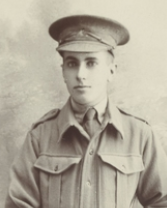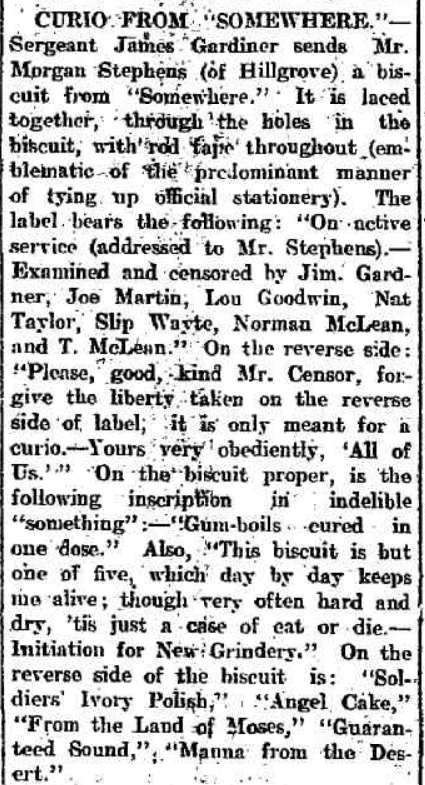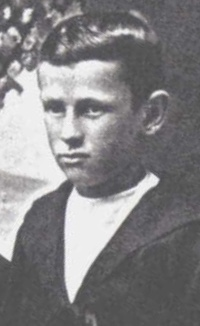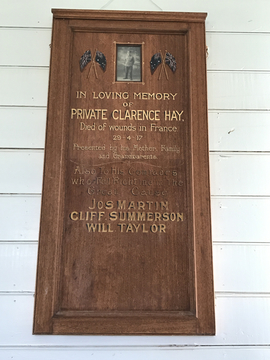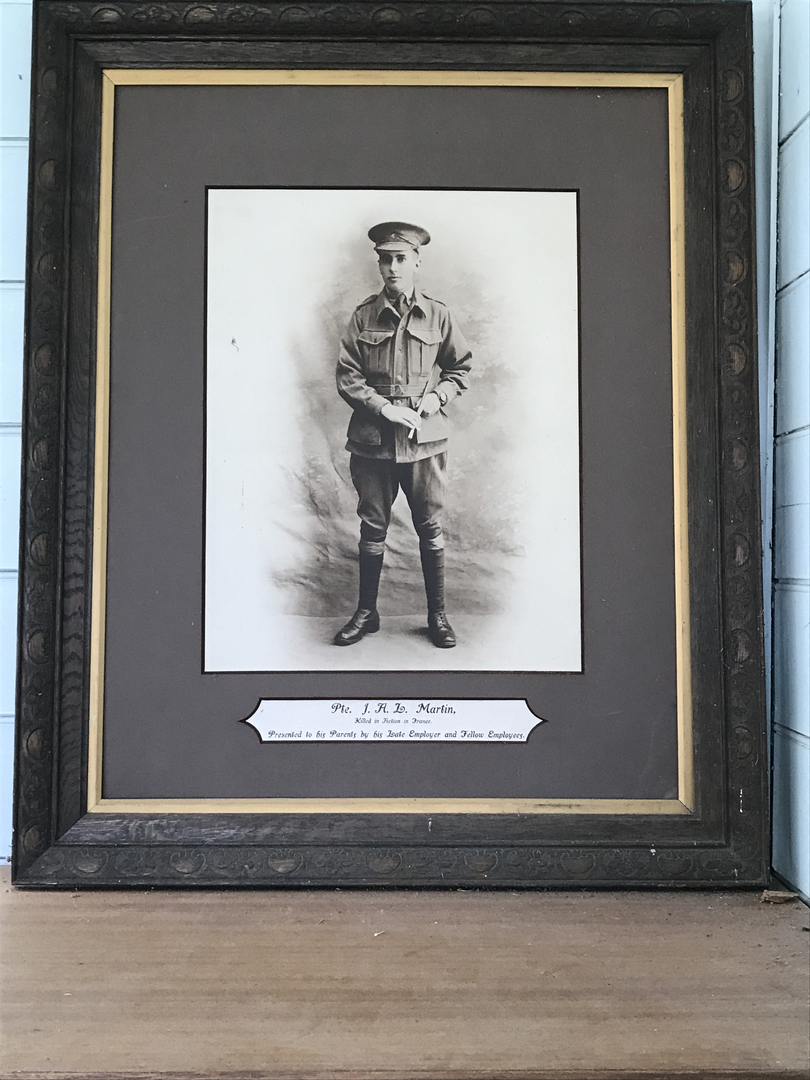Joseph Archibald Loraine MARTIN
Eyes blue, Hair brown, Complexion fair
Joseph Martin “Hillgrove Friend and Mate”
Life Before the War
Joe was born in 1894 in South Grafton, New South Wales, the eldest son of Joseph Champion Martin (1869-1924) and Mary Jane Martin (1869-1917) née Mannix. Joseph was from Bathurst, family from Cornwall, Mary from Warialda. Shortly after Joe’s birth, the family settled in Hillgrove, a major gold and antimony mining town near Armidale in the New England region of NSW. Joe’s father, a respected community leader, went on to serve as an alderman and later as Mayor of Hillgrove.
At its peak in 1898, the population was about 3000, now less than 100. Joe’s Cornish grandparents and their large family had also come via Bathurst and many lived in the Hillgrove district, perhaps they came from a Cornwall mining background and Hillgrove explaining the Bathurst and Hillgrove gatherings.
Joe grew up with seven surviving siblings, as the eldest he was the only one old enough to enlist:
- Joseph Archibald , 1894-1916 Fromelles
- Ivy Genevieve , 1896-1959 m Alfred Allingham
- Reta Victoria, 1897-1990 m Chas Purkiss
- Elizabeth C, 1899-1903 (died infancy),
- Olive M, 1901-1901 (died infancy),
- William Leslie, 1902-1971 m Emily Frazier
- Clarence James, 1905-1978 m Alice Jones
- Mary Isobel (Polly), 1907-1993 m Arthur Gray
- Albert Newton, 1910-1978 m Madge Chisholm
- John Joyce, 1913-1992 m J Blacklock
They attended Hillgrove Public School and were raised in the Methodist faith.
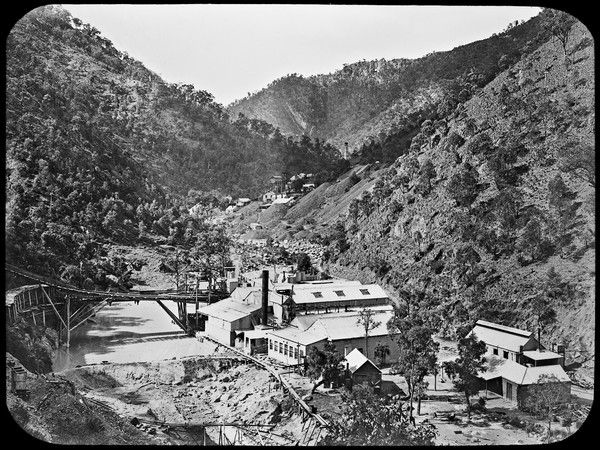
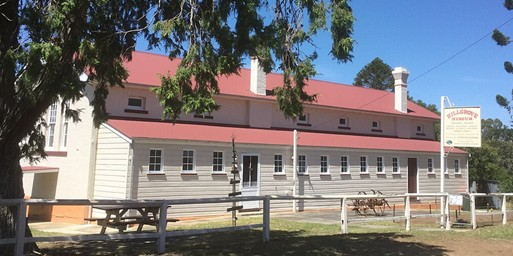
.
After leaving school, Joe worked as a grocer — he was employed in Armidale and had a reputation for reliability and service. His employer and co-workers thought highly of him, as evidenced by a framed tribute later presented to his parents after his death. Joe was one of many young men from Hillgrove who answered the call to serve, known for his cheerful nature, commitment to duty, and strong ties to the local community. He was active in local organisations, including the Methodist Church. In the early months of the war, his decision to enlist was noted with pride in the regional newspaper:
"Amongst the latest to don khaki are Messrs. Roy Rooke, Joseph A. L. Martin, and Louis Goodwin, all of Hillgrove. The two latter are well-known and highly respected in the town and district."
Off to War
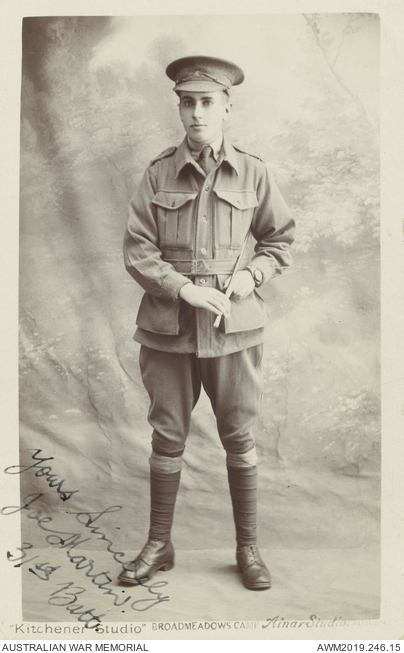
Joe was just 21 years old when he enlisted on 28 October 1915 at Armidale, alongside two of his closest friends from Hillgrove, Louis John Goodwin and William Henry Logan. The trio were well known in their community, and their enlistment together was a source of pride for the small mining town they called home. Joe and Lou were both assigned to A Company, 31st Battalion, while William joined the 33rd Battalion and was later transferred to the 3rd Machine Gun Battalion. Though they were posted to different units, the three remained in contact during training and early deployment, united by their shared background and bond.
They would later be remembered in the local press as the “Hillgrove Mates” — three young men who went to war together and never returned. After initial training, Joe embarked from Melbourne on 18 February 1916 aboard HMAT A70 Ballarat. He disembarked at Suez on 23 March 1916 and joined the 31st Battalion at the Duntroon Plateau, where the men trained in preparation for service on the Western Front. A minor disciplinary incident — being absent from duty for part of a day — resulted in a brief confinement and loss of pay, a common occurrence among new recruits adjusting to army life.
He was officially taken on strength with the Battalion on 1 April 1916. During this period in Egypt, Joe and his mates demonstrated their signature Hillgrove humour.
A curious parcel was received by Mr. Morgan Stephens of Hillgrove — a hard army biscuit, laced with red tape and labelled as a “souvenir” from “Somewhere.” It was signed by six local boys, including Joseph Martin, Louis Goodwin, and other familiar names from the district:
“The label bears the following: ‘On active service… examined and censored by Jim Gardner, Joe Martin, Lou Goodwin, Nat Taylor, Slip Wayte, Norman McLean, and T. McLean.’”
Written across the biscuit in indelible pencil were inscriptions like:
This biscuit is but one of five, which day by day keeps me alive; though very often hard and dry, tis just a case of eat or die.”
Even amid the rigours of war, Joe retained his sense of humour and camaraderie — qualities that helped keep morale high among the young men far from home.
On 16 June 1916, Joe departed Alexandria for France, arriving at Marseilles on 23 June. Within weeks, the Battalion was moved into the trenches near Fleurbaix, a quiet sector of the front at the time — though that was soon to change. In the days leading up to the Battle of Fromelles, tension ran high in the trenches near Fleurbaix, where the 31st Battalion had been positioned for their first major action on the Western Front.
On the night of 17 July 1916, Joe’s friend and fellow Hillgrove mate, Private Louis (Lou) John Goodwin, was sent out on a dangerous reconnaissance patrol with five others from A Company. Their mission was to crawl into No-Man’s-Land and assess whether the German wire defences had been adequately cut in preparation for the main assault. Only five men returned. Lou did not. His death was confirmed by multiple Red Cross eyewitnesses. Corporal Lane, one of the patrol, reported that he touched Lou’s body on his way back and received no response. Others saw his body from the trenches the following day but were unable to retrieve him. Lou’s loss would have been keenly felt by Joe and the others.
The two had trained together, fought side-by-side, and shared lighter moments — including the now-famous “censored biscuit” sent home to Hillgrove just weeks earlier. Now, one of the Hillgrove Mates was gone before the battle had even begun.
The Battle of Fromelles
On the night of 19 July 1916, Joe and the men of the 31st Battalion, A Company faced their baptism of fire on the Western Front. It was meant to be a diversion — an attack designed to pin down German troops while the British launched their Somme offensive further south. Instead, it became one of the most disastrous and heartbreaking battles in Australian military history.

19 July 1916 – Into Position
The 31st Battalion was positioned just outside the village of Fleurbaix, in a sector where the Germans had held the high ground since 1914. The ground was flat and open, with waterlogged clay soil and little natural cover. German machine guns had been carefully emplaced, and their trenches overlooked the Australian line. Joe’s A Company formed part of the first and second waves of the assault, scheduled to advance as soon as the supporting artillery barrage lifted. The final Australian bombardment began just after 4.00 PM. While impressive, it was uneven — and in key areas, the German barbed wire was left intact.
By 5.45 PM, the men of the 31st were standing ready on the fire step, bayonets fixed. The assault began at 5.53 PM. Joe and his mates from Hillgrove — already devastated by the loss of Lou Goodwin two nights earlier — went over the top into No-Man’s-Land.
Crossing No-Man’s-Land
The Germans were ready.
As soon as the barrage lifted, German machine guns opened up from Delangre Farm and along the length of the line. The 31st Battalion had to cross about 120 metres of exposed ground, in daylight, under withering fire. Some men were cut down immediately. Others, like Joe, kept moving — using the shallow shell craters for cover. Despite the devastating losses, pockets of the 31st Battalion reached the German front line trench and began engaging in close-quarter combat.
Inside the enemy trenches, visibility was poor, communication was broken, and reinforcements were slow to arrive. Joe’s group was likely part of those who fought desperately to hold the German first line, and possibly attempted to move forward toward the main support trench — only to find themselves isolated, low on ammunition, and encircled.
Joe’s Death
Two soldiers gave compelling eyewitness accounts:
“On the 19th July he [Martin] and 5 others were killed by a pigeon bomb. I saw his dead body at Fleurbaix… I know nothing of his burial.”— 2294 Pte John Caldwell, A Company, 31st Bn
“On the 19th July at Fleurbaix, Informant saw Martin hit in the shoulder by shrapnel while in the front line of trenches. Martin lay down and Informant did not see him again.”— 2151 Pte William Madigan, 31st Bn
Joe’s body was never recovered, though witnesses were certain he had died. The official service file records he was “buried in the vicinity of Fleurbaix, Sheet 36 NW”, but like so many of his comrades, his grave was never found.
By Morning – 20 July 1916
The battle raged into the night. By dawn, the attack had collapsed. Isolated groups of Australians who had reached the German lines were either killed, captured, or forced to retreat under fire across No-Man’s-Land. The ground was littered with the wounded and dead. Joe Martin — grocer, eldest brother, friend, and volunteer — had survived just one month on the Western Front. He was 22 years old. Following the disaster at Fromelles, confusion reigned.
With so many men killed, wounded, or missing in a single night, and with few survivors making it back from the German lines, casualty reports were slow, contradictory, and often incomplete. Joe’s family in Hillgrove first received word that he had been wounded. A few weeks later, that was changed to “wounded and missing.” For months, his parents Joseph and Mary continued to hope for better news — perhaps that he had been captured, or was recovering in a hospital.
Then, in December 1916, almost five months after the battle, the truth finally arrived:
“Mr. J.C. Martin has received information from the Military Authorities stating that his son Private J.C. Martin was killed in action about the 20th July. About August last Mr. Martin was informed that Joe was wounded, and a month later, he was reported wounded and missing, and the latest sad news was received during the past week.”
Joe’s name appeared on multiple casualty lists and was later honoured by both the Methodist Church and Oddfellows Lodge in Hillgrove. His sacrifice was recognised in the years that followed with several tributes in the Armidale Chronicle and Armidale Express, and his name was included on the Hillgrove Fallen Soldiers Honour Roll unveiled in 1921. Despite confirmation of his death, Joseph’s body was never recovered.
A handwritten note on his B103 service form simply reads:
Buried in vicinity of Fleurbaix, Sheet 36 NW.
The grief of the Martin family was compounded by the loss of Joe’s close friend Lou Goodwin, who had died only days earlier — and later, William Logan, the third of the Hillgrove trio. A local newspaper would later note the tragic finality of their bond:
A sad feature of the death of Pte. W. Logan, of Armidale, is the fact that he was the last of three mates, who enlisted together from Hillgrove… The whole of this gallant trio have died for their country.
Sadly, none of the trio would return:
- Private Louis John Goodwin was killed in action on 17 July 1916 during a dangerous night patrol near Fleurbaix. His body was never recovered.
- Private Joseph Martin (31st Battalion), was killed in action on 20 July 1916 during the Battle of Fromelles. Witnesses later recalled he was hit by a bomb or shrapnel and never seen again. He, too, has no known grave, and is commemorated at VC Corner, Fromelles.
- Private William Logan (3rd Machine Gun Battalion), survived longer than his friends. But on 30 September 1917, he was killed in action in Belgium during the Ypres campaign. He is remembered at the Menin Gate Memorial in Ypres, alongside thousands of others with no known burial place.
Aftermath
Joe is commemorated at:
- V.C. Corner Australian Cemetery Memorial, Fromelles, France
- Australian War Memorial Roll of Honour, Panel 119
- Armidale Memorial Fountain, Armidale, NSW
- Hillgrove Methodist Church Pictorial Honour Board, Hillgrove, NSW
At the time of Joe’s death, his parents, Joseph (a former alderman and mayor of Hillgrove) and Mary Jane Martin, were living in Taylor Street, Armidale. In honour of their son, a memorial presentation was made to them by Joseph’s former employer and fellow employees, inscribed:
Pte. J. A. L. Martin,Killed in Action in France.Presented to his Parents by his Late Employer and Fellow Employees
Family have come forward to donate DNA on behalf of Joe, If you are related to Joseph Martin or his extended family, please contact the Fromelles Association of Australia to learn how you can assist with the identification process.
DNA samples are being sought for family connections to
| Soldier | Joseph Archibald Lorraine Martin (1894–1916) |
| Parents | Joseph Champion Martin (1869–1924) and Mary Jane Mannix (1869–1917) |
| Siblings | Ivy Genevieve Martin (1896–1959) m. Alfred Allingham | ||
| Reta Victoria Martin (1897–1990) m. Charles Purkiss | |||
| Elizabeth C. Martin (1899–1903) – died in infancy | |||
| Olive M. Martin (1901–1901) – died in infancy | |||
| William Leslie Martin (1902–1971) m. Emily Frazier | |||
| Clarence James Martin (1905–1978) m. Alice Jones | |||
| Mary Isobel “Polly” Martin (1907–1993) m. Arthur Gray | |||
| Albert Newton Martin (1910–1978) m. Madge Chisholm | |||
| John Joyce Martin (1913–1992) m. J. Blacklock |
| Grandparents | |||
| Paternal | William Henry Martin (1839–1899) and Mary Jane White (1841–1906) | ||
| Maternal | John Mannix (1842–1911) and Mary A. Bowman (1846–1913) |
Links to Official Records
Seeking DNA Donors

Contacts
(Contact: carla@fromelles.info or geoffrey@fromelles.info).
(Contact: army.uwc@defence.gov.au or phone 1800 019 090).
Donations
If you are able, please contribute to the upkeep of this resource.
(Contact: bill@fromelles.info ).
